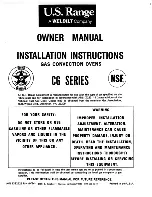
6
OTHER HELPFUL INFORMATION
GETTING THE BEST
RESULTS FROM YOUR
MICROWAVE OVEN
Keep an eye on things. The instructions in
this book have been formulated with great
care,
but your success in preparing them
depends, of course, on how much attention you
pay to the food as it cooks. Always watch your
food while it cooks. Your microwave oven is
equipped with a light that turns on automatically
when the oven is in operation so that you can
see inside and check the progress of your recipe.
Directions given in recipes to elevate, stir, and
the like should be thought of as the minimum
steps recommended. If the food seems to be
cooking unevenly, simply make the necessary
adjustments you think appropriate to correct the
problem.
Factors affecting cooking times.
Many factors
affect cooking times. The temperature of
ingredients used in a recipe makes a big
difference in cooking times. For example, a cake
made with ice-cold butter, milk, and eggs will
take considerably longer to bake than one made
with ingredients that are at room temperature.
All of the recipes in this book give a range of
cooking times. In general, you will find that the
food remains under-cooked at the lower end of
the time range, and you may sometimes want to
cook your food beyond the maximum time given,
according to personal preference. The governing
philosophy of this book is that it is best for a
recipe to be conservative in giving cooking times.
While undercooked food may always be cooked
a bit more, overcooked food is ruined for good.
Some of the recipes, particularly those for bread,
cakes, and custard, recommend that food be
removed from the oven when they are slightly
undercooked. This is not a mistake. When
allowed to stand, usually covered, these foods
will continue to cook outside of the oven as the
heat trapped within the outer portions of the
foods gradually travels inward. If the foods are
left in the oven until they are cooked all the way
through, the outer portions will become
overcooked or even burnt.
As you gain experience in using your microwave
oven, you will become increasingly skillful in
estimating both cooking and standing times for
various foods.
PRECAUTIONS
*
Be certain to place the front surface of the door
three inches away or more from the countertop
edge to avoid accidental tipping of the appliance
in normal usage.
*
For the most accurate programming of the
electronic units, touch the center of each pad
securely. Do not touch several pads at one time
or touch between pads. A beep sound should
be heard with each touch when a pad is
touched correctly.
*
Do not hit or strike the control with objects such
as silverware, utensils, etc. Breakage may
occur.
*
Be careful when taking the cooking utensils out
of the oven. Some dishes absorb heat from the
cooked food and may be hot.
*
Do not rinse cooking utensils by immediately
placing them into water just after cooking. This
may cause breakage. Allow the turntable to
cool.
*
Use only specific glass utensils. See cooking
utensils section in this manual.
*
Do not operate the oven empty. Either food or
water should always be in the oven during
operation to absorb microwave energy.
*
Do not use your microwave oven to dry
newspapers or clothes. They can catch fire.
*
Use only thermometers approved for microwave
oven cooking.
*
Be certain the turntable is in place when you
operate the oven.
*
Pierce the skin of potatoes, whole squash,
apples, or any fruit or vegetable which has a
skin covering before cooking.
*
Never use your microwave oven to cook eggs in
the shell. Pressure can build up inside the shell
causing it to burst.
*
Do not pop popcorn, except in a microwave-
safe container or commercial package designed
especially for microwave ovens.
Never try to pop popcorn in a paper bag not
designed for microwave oven use. Overcooking
may result in smoke and fire. Do not repop
unpopped kernels. Do not reuse popcorn bags.
Содержание MA-7802
Страница 14: ...P NO 3828W5A1267 Printed in China ...
































